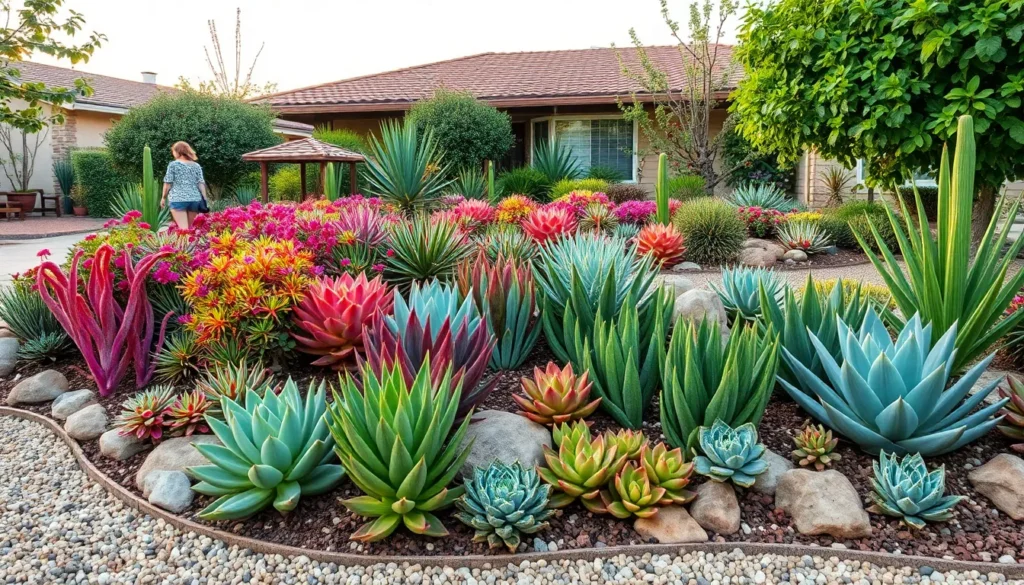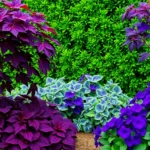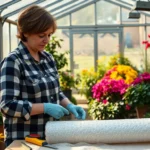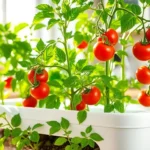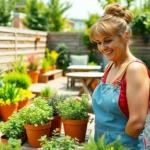Transform your front yard into a stunning low-maintenance oasis with the endless possibilities of succulent gardening. We’ve discovered that these drought-tolerant beauties aren’t just perfect for busy homeowners – they’re also incredibly versatile design elements that can create breathtaking curb appeal year-round.
From dramatic agave centerpieces to colorful echeveria borders we’ll show you how succulents can completely revolutionize your outdoor space. These resilient plants thrive in various climates and require minimal watering making them ideal for modern landscaping challenges.
Whether you’re working with a small front garden or expansive yard space we’ve compiled creative ideas that’ll make your neighbors stop and admire. Get ready to discover how simple succulent arrangements can boost your home’s value while creating an Instagram-worthy entrance that practically maintains itself.
Create a Dramatic Focal Point With Large Architectural Succulents
Large architectural succulents transform ordinary front yards into striking landscapes that command attention from every passerby. These magnificent plants serve as living sculptures that anchor your design while requiring minimal maintenance.
Position Century Plants as Statement Pieces
Century plants create unmatched drama with their massive rosettes and sword-like leaves that can span 6 to 8 feet across. We recommend placing these agave specimens at corners of walkways or flanking your front entrance where they’ll have room to reach their full potential. Their blue-green foliage with cream-colored edges adds year-round visual interest that complements both modern and southwestern architectural styles.
Position your century plant at least 8 feet from walkways and 10 feet from your home’s foundation to accommodate their eventual size. These architectural giants produce spectacular flower stalks that can reach 20 to 30 feet tall after 10 to 30 years, creating once-in-a-lifetime displays before the plant completes its life cycle. Plant them in well-draining soil with full sun exposure for optimal growth and color development.
Use Barrel Cacti for Bold Geometric Appeal
Barrel cacti bring perfect spherical forms that create striking geometric contrast against angular hardscaping and linear planting beds. We love using golden barrel cacti in groups of three or five to establish rhythmic patterns that guide the eye through your front yard design. Their bright yellow spines catch morning and evening light beautifully while their compact 2 to 3-foot mature size makes them ideal for smaller spaces.
Group different sized barrel cacti together to create ever-changing compositions that look natural yet intentional. These desert natives thrive in gravelly, fast-draining soil and can withstand temperatures down to 20°F in most climate zones. Their slow growth rate means your investment will maintain its intended scale for decades without requiring frequent replacements or major pruning.
Incorporate Tree-Form Jade Plants for Height Variation
Tree-form jade plants provide the vertical structure your succulent garden needs while maintaining the drought-tolerant benefits you’re seeking. We’ve seen these sculptural beauties reach 6 to 8 feet tall with thick, branching trunks that resemble miniature trees in Mediterranean and coastal gardens. Their glossy green leaves create dense canopies that offer subtle shade for smaller succulents planted beneath.
Plant jade trees in areas with morning sun and afternoon shade to prevent leaf scorch while encouraging compact, bushy growth. These versatile succulents adapt well to container planting, allowing you to create moveable focal points that can be repositioned seasonally or relocated during extreme weather events. Their pink or white star-shaped flowers appear in late fall and winter, adding unexpected seasonal color when most other plants are dormant.
Design Eye-Catching Color Combinations With Mixed Succulent Varieties
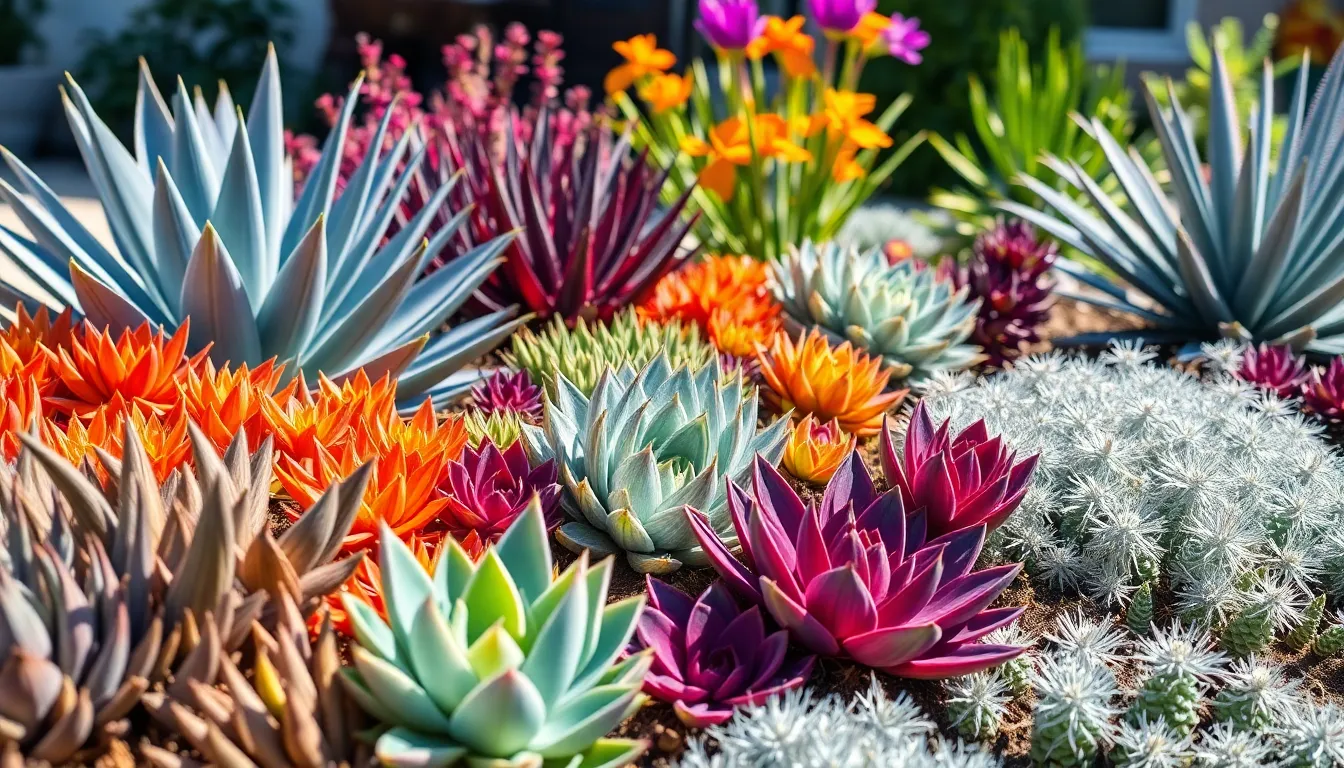
Creating stunning visual impact in your front yard succulent garden starts with strategic color pairing. We’ll show you three proven combinations that deliver maximum curb appeal with minimal maintenance.
Pair Blue-Toned Agaves With Orange Sedums
Blue gray agaves create bold statements when positioned as centerpieces in your succulent garden design. Agave parryi works exceptionally well with its striking blue toned leaves that command attention from every angle.
Orange sedums provide the perfect complementary contrast to cool blue agave foliage. Sedum adolphii ‘Firestorm’ delivers vibrant orange hues that intensify during cooler months. Plant these colorful sedums around your agave’s base to create a natural border that draws the eye inward.
This combination works because complementary colors on the color wheel create maximum visual tension. Position your blue agave in the center or rear of planting beds where it can be viewed from 360 degrees for optimal impact.
Combine Purple Aeoniums With Silver Dusty Miller
Dark purple aeoniums add dramatic sophistication to any front yard succulent arrangement. Aeonium arboreum varieties offer rich burgundy and deep purple foliage that creates stunning focal points in your industry design.
Silver dusty miller softens harsh purple tones while adding brightness to shadowy areas. Senecio cineraria features silvery white leaves that reflect light and create beautiful textural contrast against smooth aeonium rosettes.
We recommend planting dusty miller in clusters around purple aeoniums to create flowing transitions between plants. This pairing works particularly well in partially shaded areas where the silver foliage can brighten darker spaces.
Mix Red Echeveria With Green Hens and Chicks
Red echeveria varieties provide rich jewel tones that anchor your succulent color scheme. Echeveria ‘Red Velvet’ and ‘Black Prince’ offer deep red and burgundy colors that intensify in bright sunlight and cooler temperatures.
Green sempervivum creates lush backgrounds that make red echeveria colors pop dramatically. Hens and chicks spread naturally to form dense groundcover that fills spaces between larger specimens.
Surround your red echeveria with expanding colonies of green sempervivum for a harmonious look that appears professionally designed. This combination thrives in full sun locations where color intensity reaches its peak during stress periods.
Build Stunning Raised Beds and Terraced Gardens
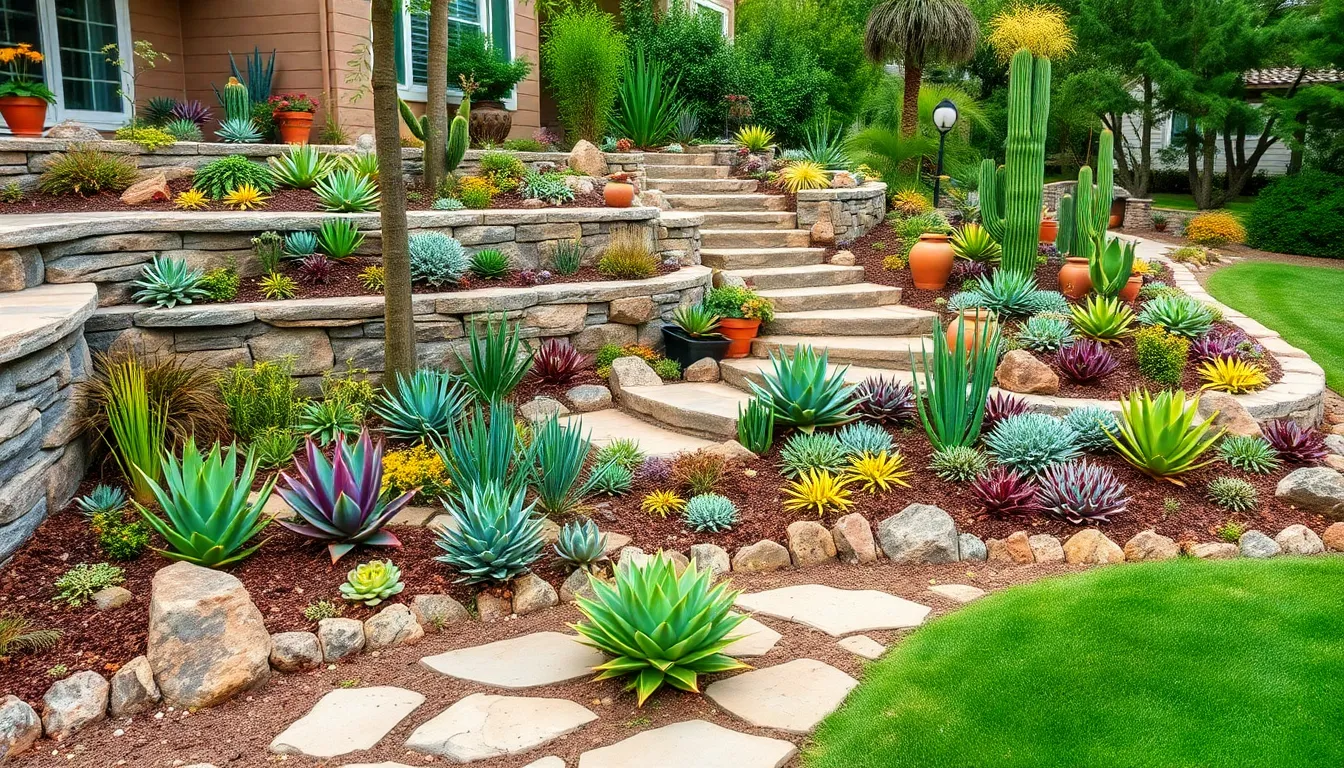
Elevated planting transforms your front yard succulent display by improving both drainage and visual appeal. These structures solve the common challenge of poor soil conditions while creating architectural interest that complements your colorful succulent combinations.
Construct Stone Retaining Walls for Drainage
Stone retaining walls provide the structural foundation your terraced succulent garden needs to thrive. We recommend building these walls using natural stone materials like limestone or sandstone, which offer both durability and aesthetic appeal that matches the organic nature of succulents.
Drainage benefits make stone walls essential for succulent health. These structures prevent soil erosion while allowing excess water to flow away from plant roots, reducing the risk of root rot that commonly affects these drought-tolerant plants.
Aesthetic versatility allows stone walls to complement any front yard design style. Modern homes benefit from clean-cut stone blocks arranged in geometric patterns, while traditional properties shine with natural fieldstone walls that create a rustic, organic appearance.
Create Multi-Level Planting Areas
Layered landscaping showcases your succulent collection by creating distinct zones for different plant sizes and textures. We design these multi-level areas to highlight the natural growth patterns of various succulent species while making maintenance tasks more accessible.
Strategic plant placement maximizes visual impact across all viewing angles. Taller specimens like agaves and yuccas anchor the highest levels, providing dramatic backdrop elements that draw the eye upward from street level.
Size gradation creates natural flow between planting levels. Medium-height plants like barrel cacti and tree-form jade occupy middle tiers, while compact varieties such as echeveria and sedums fill lower areas with intricate textures and colors.
Install Decorative Rock Borders for Definition
Decorative rock borders create clean separation between different garden zones while improving water conservation efforts. We select rocks that complement your stone retaining walls, typically using materials like decomposed granite, river rock, or crushed stone in coordinating colors.
Visual organization helps define pathways and planting areas within your terraced design. These borders guide visitors’ eyes through your succulent display while preventing soil migration between different elevation levels.
Moisture retention benefits occur when rock borders trap morning dew and reduce surface evaporation around plant bases. This natural water conservation technique supports your succulents’ drought-tolerant nature while minimizing irrigation needs throughout dry seasons.
Incorporate Hardscape Elements for Year-Round Interest
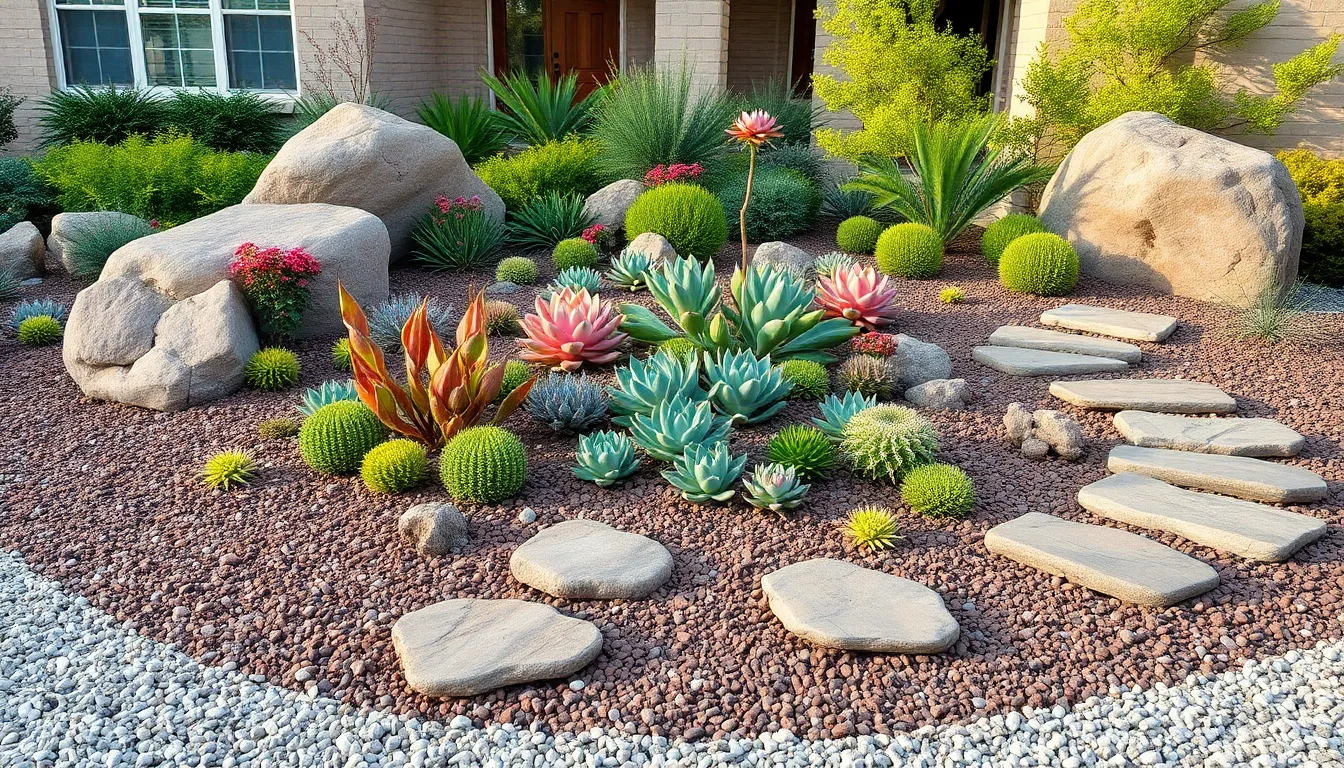
Hardscape elements transform succulent gardens from simple plant displays into sophisticated industry designs that maintain visual appeal throughout every season. These structural features provide permanent beauty even when plants enter dormancy periods.
Add Gravel Pathways Between Planting Areas
Gravel pathways create functional navigation routes while adding visual interest to your succulent garden design. These pathways make it easier to move between different planting zones without disturbing delicate root systems or compacting soil around your plants.
Drainage benefits make gravel an ideal choice since succulents require excellent water management to prevent root rot. The permeable surface allows excess moisture to filter through naturally while creating defined borders between garden sections.
Material options include decomposed granite for a natural look, crushed stone for durability, or decorative pea gravel for color variation. We recommend choosing neutral tones like gray or tan to complement your succulent colors without overwhelming the overall design.
Installation tips involve excavating 2-3 inches deep and adding industry fabric underneath to prevent weed growth. This foundation ensures your pathways remain clean and low maintenance for years to come.
Include Large Boulders as Natural Anchors
Large boulders serve as visual anchors that create focal points and add dramatic scale to succulent garden compositions. These natural elements provide permanent structure that enhances the garden’s appeal during all seasons and weather conditions.
Strategic placement involves positioning boulders at key intersections or corners to define different garden zones naturally. We suggest using odd numbers of stones in various sizes to create more ever-changing and visually pleasing arrangements.
Natural materials like sandstone, limestone, or granite work best because they complement succulent textures and colors effectively. Local stone varieties often provide the most authentic appearance while reducing transportation costs and environmental impact.
Design benefits include creating microclimates where smaller succulents can shelter from harsh winds or intense sun exposure. Boulders also help prevent soil erosion on sloped areas while adding depth and dimension to flat industry designs.
Install Decorative Stepping Stones for Access
Decorative stepping stones provide practical access points throughout your succulent garden while serving as artistic elements that enhance overall visual appeal. These features allow you to tend plants and enjoy close up views without damaging surrounding vegetation.
Material choices range from natural flagstone and slate to concrete pavers with decorative patterns or embedded designs. We prefer materials that complement your home’s architectural style and existing hardscape elements for cohesive design flow.
Spacing considerations involve placing stones 18-24 inches apart for comfortable walking stride while ensuring stable footing on uneven terrain. This distance prevents overcrowding the visual space while maintaining functional access throughout the garden.
Installation benefits include creating defined maintenance routes that protect plant root zones from foot traffic damage. Stepping stones also add textural contrast against soft succulent forms while providing opportunities to incorporate artistic elements like mosaic designs or carved patterns.
Plan Strategic Arrangements for Maximum Curb Appeal
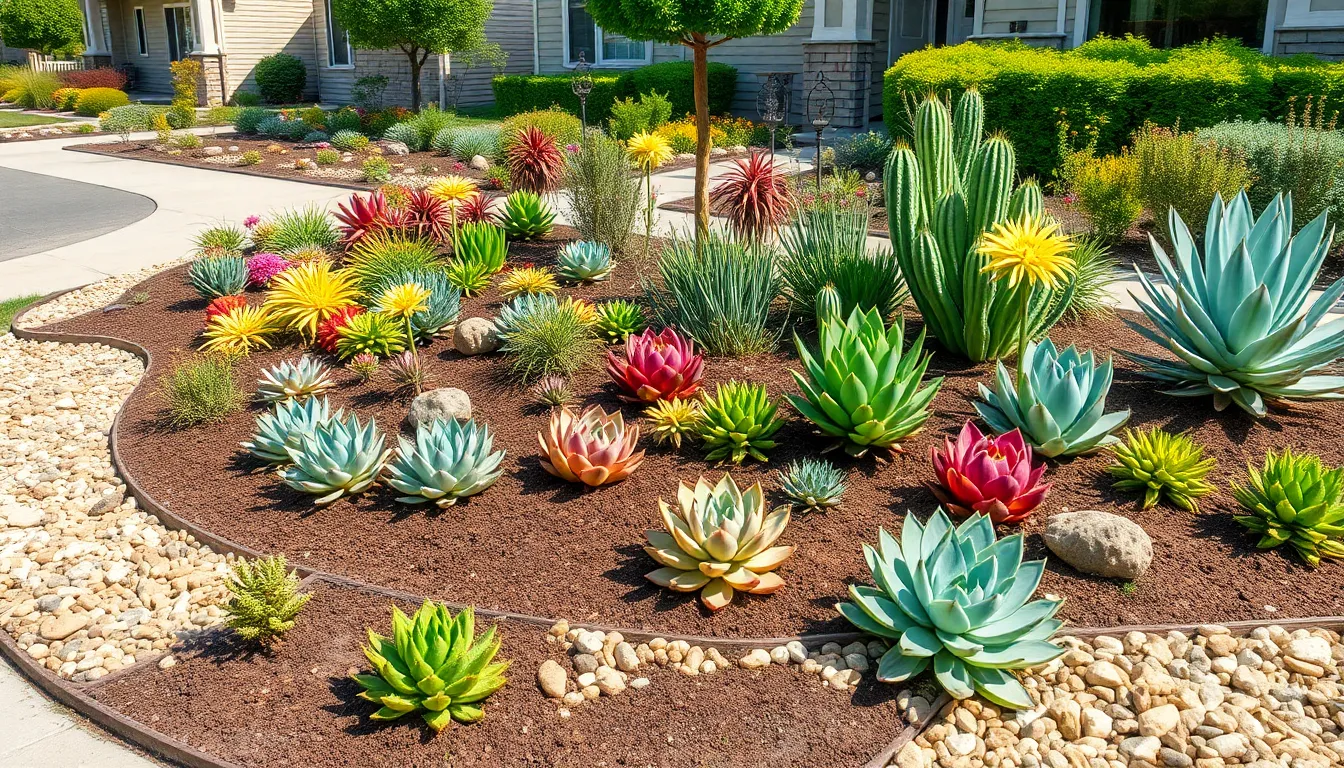
Strategic placement forms the foundation of any successful front yard succulent garden that commands attention from the street. We’ll explore three essential principles that transform ordinary plant collections into professionally designed landscapes.
Follow the Rule of Odds for Plant Groupings
Grouping succulents in odd numbers creates more visually appealing arrangements than even-numbered clusters. Three large barrel cacti positioned together generate stronger visual impact than two or four specimens placed side by side. Five smaller echeveria rosettes arranged in a triangular pattern draw the eye naturally while maintaining balance.
We recommend starting with groups of three plants when designing your main focal areas. Larger specimens like agaves work exceptionally well in triangular formations where the tallest plant anchors the back position. Smaller varieties such as sedums and jade plants benefit from five-plant groupings that create fuller, more ever-changing displays.
The psychological appeal of odd numbers stems from how our brains process visual information. Even groupings appear static and predictable while odd arrangements feel more organic and captivating to viewers.
Create Flowing Lines That Guide the Eye
Flowing lines direct visitors’ attention through your garden while establishing smooth visual transitions between different areas. We achieve this effect by incorporating plants with varying heights and growth patterns that create natural pathways for the eye to follow. Tall yucca plants positioned at key intervals establish vertical anchors while lower mounding succulents like hens and chicks fill transitional spaces.
Curved planting beds work more effectively than straight lines for creating movement through the industry. We suggest using serpentine arrangements where taller specimens like century plants mark curve points and smaller varieties fill the flowing spaces between them. This technique mimics natural growth patterns found in desert environments.
Mounding soil beneath plantings enhances the flowing effect while improving drainage conditions that succulents require. These gentle elevation changes add depth and prevent the flat appearance that often plagues beginner succulent gardens.
Balance Dense Clusters With Open Spaces
Dense succulent clusters require strategic placement alongside open areas to prevent visual overwhelm and maintain healthy growing conditions. We position tight groupings of plants like colorful aeonium rosettes at exact focal points while leaving breathing room between major planting zones. This approach allows each cluster to stand out while creating opportunities for decorative elements like ornamental gravel or sculptural rocks.
Air circulation becomes crucial when balancing density with spacing since succulent health depends on proper ventilation around plant bases. Dense plantings trap moisture and reduce airflow which can lead to fungal problems in humid climates. We maintain minimum spacing of 18 inches between major plant clusters to ensure adequate air movement.
Open spaces serve multiple purposes beyond plant health by providing visual rest areas that prevent garden designs from appearing cluttered. These negative spaces allow viewers to appreciate individual plant specimens while creating opportunities for seasonal color additions or temporary container displays that enhance curb appeal throughout the year.
Select Low-Maintenance Ground Cover Succulents
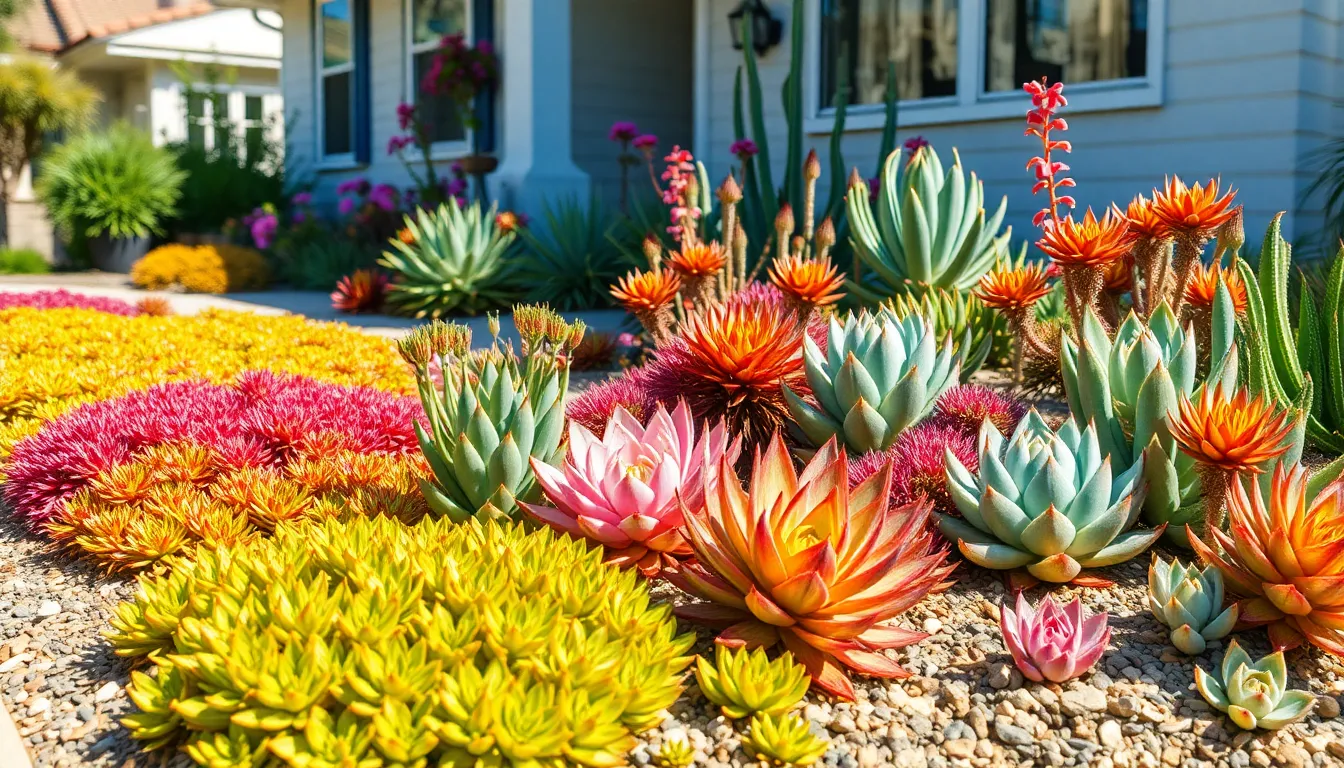
Ground cover succulents form the foundation of any successful front yard design, providing year-round beauty with minimal water requirements. We’ll explore three exceptional varieties that create stunning living carpets while requiring almost no maintenance.
Plant Creeping Sedums for Living Carpet Effects
Creeping sedums transform bare soil into lush, colorful tapestries that spread naturally across your industry. These hardy succulents create a living carpet effect, forming dense mats that suppress weeds while adding vibrant colors ranging from deep burgundy to bright chartreuse. We recommend planting different sedum varieties together to achieve a patchwork quilt appearance that changes throughout the seasons.
Popular varieties like Sedum spurium ‘Dragon’s Blood’ and Sedum kamtschaticum provide excellent coverage in both sunny and partially shaded areas. Their low-growing habit makes them perfect for slopes, rock gardens, and areas where traditional grass struggles to thrive. Most creeping sedums reach only 2-4 inches in height, making them ideal for walkway borders and foundation plantings.
Use Ice Plants for Colorful Seasonal Blooms
Delosperma, commonly known as ice plant, delivers spectacular bursts of daisy-like flowers during warmer months while maintaining attractive foliage year-round. These South African natives produce vibrant blooms in shades of pink, purple, orange, and yellow that create stunning seasonal displays against their succulent leaves. We’ve found that ice plants perform exceptionally well in hot, dry conditions where other flowering plants fail.
Fire Spinner and Cooperi varieties offer the most reliable bloom production, often flowering from late spring through early fall. Their ability to spread up to 2 feet wide makes them excellent choices for filling large areas quickly. Ice plants also provide valuable erosion control on slopes while requiring water only during establishment periods.
Establish Hens and Chicks Colonies for Texture
Sempervivum, or hens and chicks, create fascinating geometric patterns as they form expanding colonies over time. These rosette-forming succulents produce many offsets that gradually fill empty spaces, creating natural clusters that add architectural interest to your front yard design. We appreciate how these plants require virtually no care once established, making them perfect for busy homeowners.
Common houseleek and cobweb houseleek varieties offer different textures and colors, from smooth green rosettes to fuzzy, web-covered specimens. Their compact size makes them ideal for rock crevices, container gardens, and detailed border work. Hens and chicks also produce tall flower spikes in summer, adding vertical elements to otherwise low-growing displays before the parent plant completes its lifecycle and passes the colony to its offspring.
Design Container Displays for Flexible Arrangements
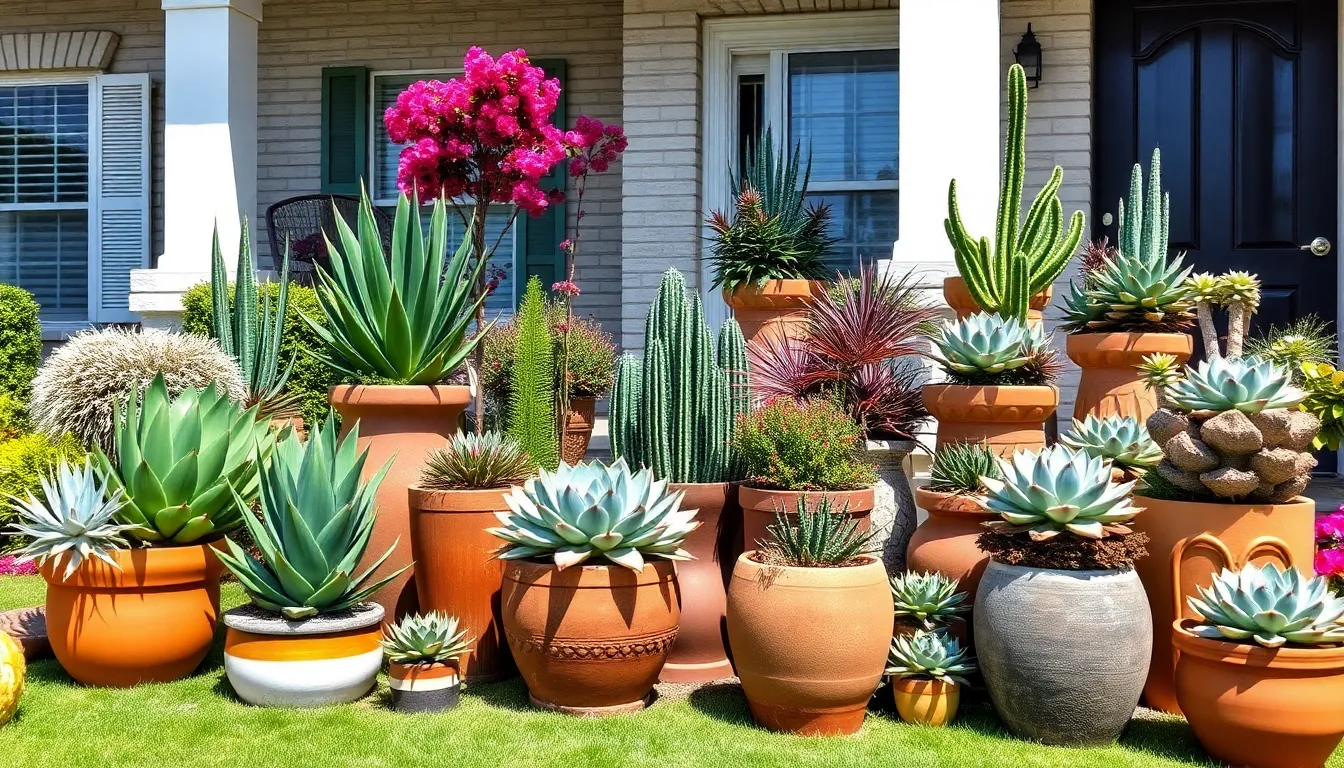
Container gardens offer us the ultimate flexibility in succulent design, allowing us to rearrange displays seasonally and experiment with different combinations. We can create stunning visual impact by mixing various succulent species in portable arrangements that complement our existing industry features.
Choose Large Statement Pots as Garden Anchors
Large statement pots serve as powerful focal points that ground our entire succulent display. We recommend selecting containers at least 18-20 inches in diameter to accommodate striking species like agaves or yuccas that command attention. These substantial vessels create natural gathering points for the eye and establish the overall scale of our garden design.
Positioning these anchor pots strategically maximizes their visual impact across our front yard. We should place them at key viewing angles from the street and our home’s entrance to ensure maximum curb appeal. Symmetrical placement of matching statement pots creates formal balance, while asymmetrical arrangements offer a more relaxed, natural aesthetic.
Bold architectural succulents thrive in these larger containers and provide year round structure. Century plants with their dramatic sword like leaves make exceptional centerpiece choices, while barrel cacti offer geometric appeal that complements modern home styles. Tree form jade plants in statement pots introduce vertical elements without overwhelming smaller neighboring displays.
Create Varied Heights With Different Container Sizes
Layering containers at different elevations transforms flat displays into ever-changing three dimensional gardens. We can achieve this depth by combining tall floor pots, medium sized planters, and smaller accent containers to create natural terracing effects. This approach allows each succulent variety to receive proper light exposure while preventing taller plants from shading shorter ones.
Stepped arrangements using plant stands or decorative risers add professional polish to our displays. We recommend grouping containers in odd numbers of three or five at varying heights to create the most visually pleasing compositions. Wooden plant stands, metal risers, or even repurposed materials like concrete blocks can elevate smaller pots effectively.
Strategic height variation showcases the unique characteristics of different succulent species. Trailing varieties like string of pearls work beautifully in elevated containers where their cascading growth can be fully appreciated. Upright specimens such as echeveria rosettes shine when positioned at mid level heights, while ground hugging sedums excel in lower profile containers.
Select Weather Resistant Materials for Durability
Durable container materials ensure our succulent displays withstand seasonal weather changes without deterioration. We prioritize terracotta, ceramic, and concrete pots for their excellent drainage properties and natural insulation that protects roots from temperature extremes. These materials also develop attractive patinas over time that enhance the overall garden aesthetic.
Proper drainage becomes critical in container succulent gardening since excess moisture cannot escape naturally. We always verify that our chosen pots include adequate drainage holes, typically one hole per 6 inches of container diameter. Adding a layer of gravel or ceramic shards at the bottom prevents soil from blocking drainage while maintaining proper air circulation around roots.
Weather resistant finishes protect our investment while maintaining visual appeal throughout the seasons. Glazed ceramic pots resist cracking in freeze thaw cycles, while sealed concrete containers prevent moisture absorption that leads to structural damage. We avoid thin plastic containers that become brittle in cold weather and may crack under the weight of mature succulents and soil.
Implement Proper Drainage Solutions for Plant Health
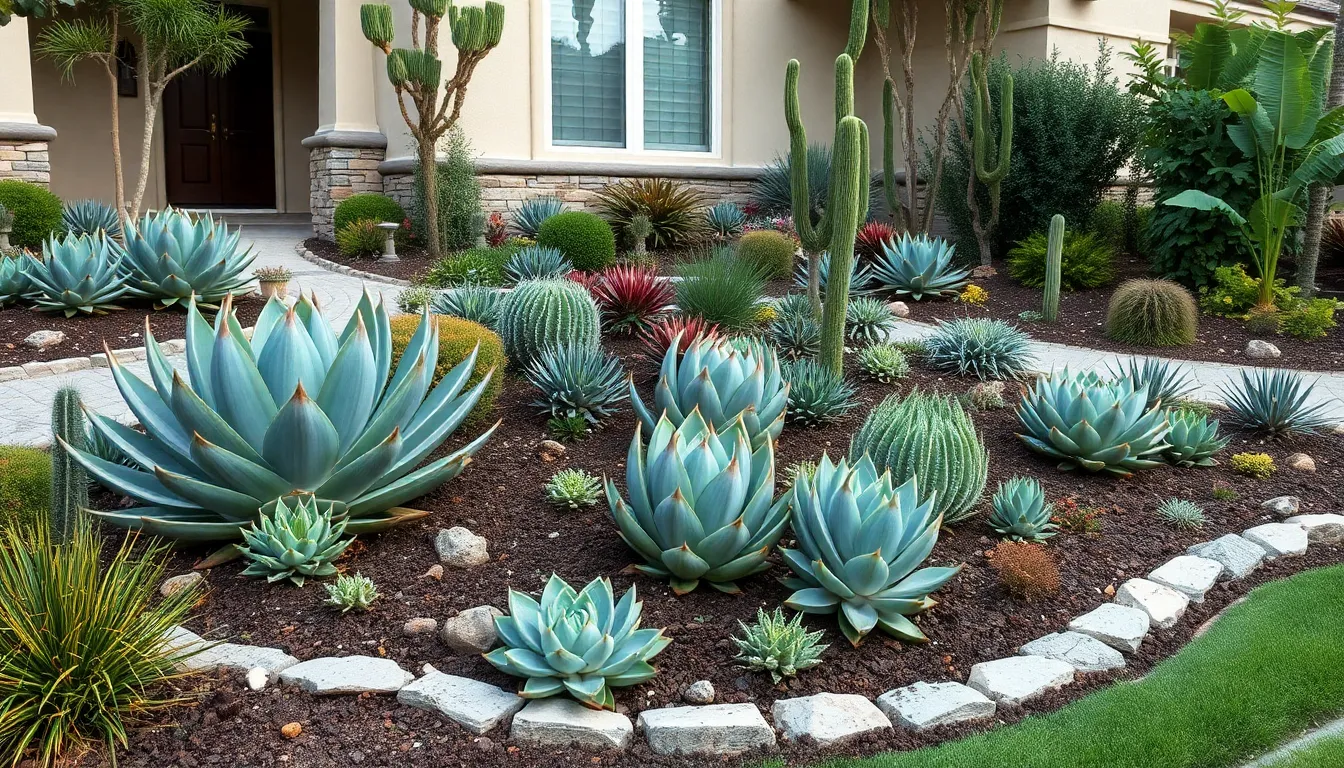
Proper drainage forms the foundation of a thriving succulent garden, preventing root rot and ensuring long-term plant health. We’ll explore three essential drainage answers that protect your investment and maintain the beauty of your front yard display.
Install French Drains in Heavy Clay Soils
French drains provide essential protection for succulent gardens in areas with heavy clay soil that retains water. We recommend installing these drainage systems to redirect excess water away from your garden beds, particularly in regions prone to seasonal rainfall or where natural soil drainage is poor.
Position your French drain system approximately 18-24 inches deep along the perimeter of your succulent garden beds. This depth allows the drain to capture water before it reaches the root zone of your plants. Fill the drainage trench with coarse gravel and wrap it with industry fabric to prevent soil infiltration while maintaining water flow.
Connect the French drain to a designated outlet area such as a storm drain, dry well, or natural slope away from your home’s foundation. This connection ensures that collected water moves away from your garden rather than pooling in unwanted areas.
Add Sand and Gravel Amendments to Planting Areas
Sand and gravel amendments transform heavy soils into well-draining environments that succulents need to flourish. We suggest mixing coarse sand and pea gravel into your existing soil at a ratio of 30-40% amendments to 60-70% native soil for optimal results.
Select coarse builder’s sand rather than fine sand, which can actually impede drainage by creating a concrete-like mixture when combined with clay. Combine this with quarter-inch pea gravel to create air pockets that allow water to move freely through the soil profile.
Work these amendments into the top 12-18 inches of soil throughout your planting areas before installing your succulents. This depth ensures proper root development while providing adequate drainage for most succulent species commonly used in front yard gardens.
Create Sloped Beds to Prevent Water Accumulation
Sloped beds use gravity to naturally move water away from succulent roots, eliminating standing water that causes plant stress and disease. We design our garden beds with a gentle 2-5% grade that provides effective drainage without creating erosion problems.
Build your raised succulent beds higher at one end, creating a subtle slope that directs water flow toward designated drainage areas. This technique works particularly well when combined with decorative stone borders that help contain soil while allowing water to exit the planting area.
Install your largest architectural succulents like agaves and barrel cacti at the higher end of the slope where drainage is most aggressive. Place smaller, more water-sensitive varieties like echeveria and sedums in the middle sections where drainage is moderate but still effective for preventing root rot.
Establish Seasonal Interest Through Bloom Cycles
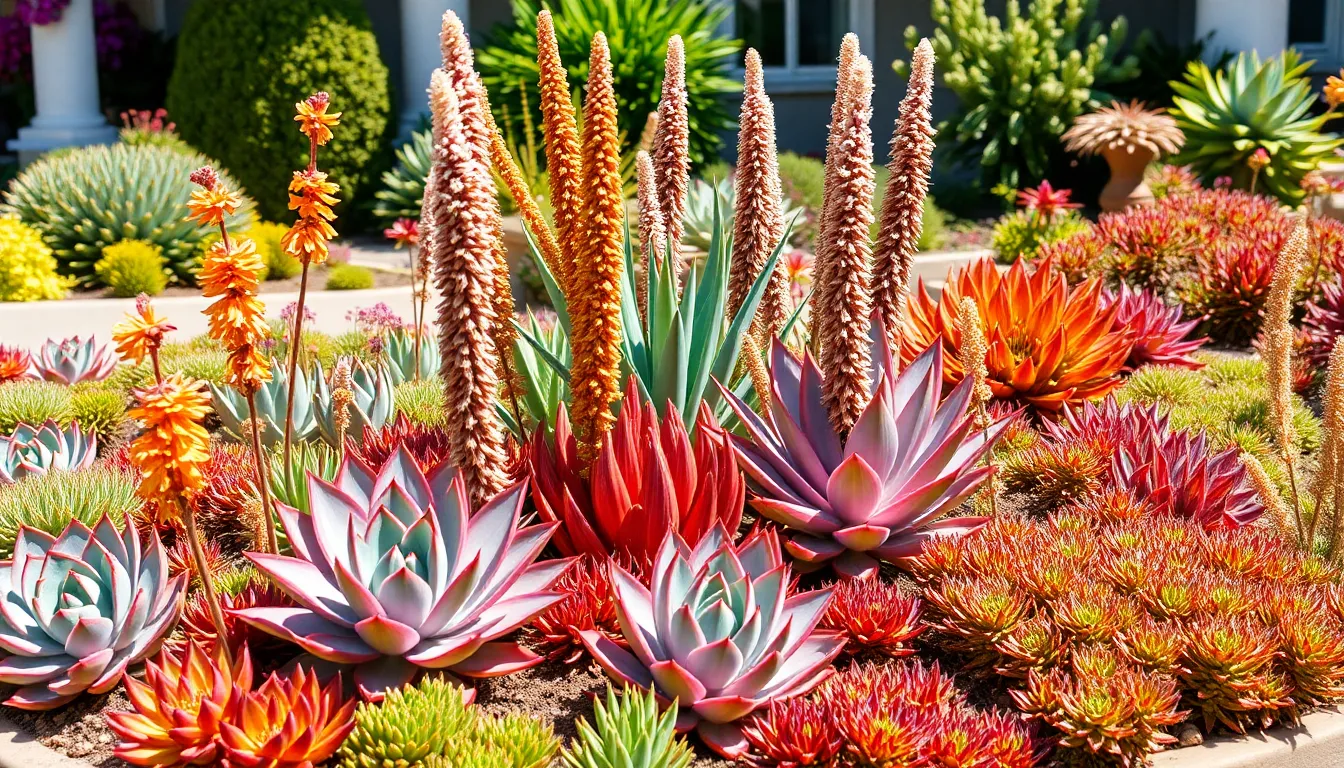
Creating a ever-changing front yard succulent garden requires strategic plant selection that delivers visual interest throughout the year. We can achieve continuous beauty by incorporating succulents that bloom and change colors across different seasons.
Plan for Spring Flowering Echeveria Varieties
Spring brings the first wave of color through carefully selected echeveria species that burst into bloom as temperatures warm. We recommend starting with Echeveria ‘Afterglow’, which produces stunning apricot-pink flowers that create a soft, romantic display against its purple-tinted rosettes. Echeveria elegans complements this with delicate bell-shaped blooms in coral and pink tones, adding graceful vertical elements to the garden composition.
Position these varieties in well-draining soil with full to partial sun exposure for optimal flowering performance. We suggest grouping three to five plants of the same variety together to create impactful color masses that draw attention from the street. Plant them in raised beds or containers where their intricate rosette patterns and spring blooms can be easily appreciated by visitors approaching your front entrance.
Include Summer-Blooming Agave Species
Summer transforms the garden with dramatic agave species that send up impressive flower spikes during the hottest months. Agave americana creates spectacular architectural statements with its massive blue-gray leaves and towering flower stalks that can reach 20 feet in height. Agave parryi offers a more compact option while still providing the sculptural impact that defines summer succulent displays.
These summer bloomers serve dual purposes in our front yard design by providing both structural backbone and seasonal spectacle. We position larger agaves as anchor plants at garden corners or entrance points where their bold forms create natural focal points. Smaller varieties work beautifully in groupings of three, creating dramatic clusters that maintain visual weight without overwhelming the space.
Add Fall-Colored Sedums for Autumn Appeal
Fall extends the growing season through sedum varieties that shift into rich autumn colors as temperatures cool. Sedum ‘Autumn Joy’ delivers exactly what its name promises, transforming from green summer foliage to deep reds and burgundy tones that rival traditional fall landscaping. Sedum ‘Dragon’s Blood’ creates carpet-like ground cover that turns brilliant crimson, adding warmth and richness to the late-season garden.
We incorporate these fall performers as transitional plants between taller agaves and lower echeverias, creating natural color gradations that guide the eye through the garden. Plant them along walkways or garden borders where their autumn transformation can be fully appreciated. These sedums also provide late-season nectar sources for pollinators, supporting local wildlife while maintaining the garden’s visual appeal through the cooler months.
Conclusion
We’ve shown you how to transform your front yard into a stunning succulent showcase that delivers maximum impact with minimal effort. From architectural statement plants to colorful ground covers these versatile plants offer endless possibilities for creating your dream industry.
Your succulent garden investment will pay dividends for years to come through reduced water bills improved curb appeal and virtually maintenance-free beauty. The combination of proper drainage strategic plant placement and thoughtful hardscaping creates a sustainable outdoor space that thrives in any climate.
Start small with container arrangements or jump into a complete industry transformation – either way you’re building something that’ll make your neighbors envious while giving you more time to enjoy your beautiful low-maintenance oasis.
Frequently Asked Questions
What makes succulents ideal for front yard landscaping?
Succulents are perfect for front yards because they’re drought-tolerant, require minimal maintenance, and thrive in various climates. These versatile plants can dramatically enhance curb appeal while reducing water bills and maintenance time. Their unique textures, colors, and architectural forms create stunning visual displays that boost home value and impress neighbors year-round.
Which large succulents work best as focal points?
Century plants (agaves) with their massive rosettes and sword-like leaves make excellent centerpieces. Barrel cacti provide bold geometric appeal, while tree-form jade plants add height variation. These architectural succulents create dramatic focal points when positioned strategically, requiring minimal care while delivering maximum visual impact in your landscape design.
What are the best color combinations for succulent gardens?
Three proven pairings include: blue-toned agaves with orange sedums for striking contrast, purple aeoniums with silver dusty miller for sophistication, and red echeveria with green hens and chicks for harmony. These combinations maximize curb appeal while maintaining low maintenance requirements, creating professionally designed looks that enhance your front yard’s visual impact.
How do raised beds benefit succulent gardens?
Raised beds improve drainage, prevent root rot, and enhance visual appeal. Stone retaining walls using limestone or sandstone prevent soil erosion while creating multi-level planting areas that showcase different plant sizes and textures. Decorative rock borders define garden zones, improve water conservation, and add organization to your succulent display.
What hardscape elements enhance succulent gardens?
Gravel pathways provide functional navigation and drainage benefits, while large boulders serve as natural anchors that create microclimates. Decorative stepping stones offer access and artistic enhancement. These hardscape features complement succulent displays while providing year-round structure and organization, ensuring your garden remains both practical and visually appealing.
How should I arrange succulents for maximum curb appeal?
Follow the “Rule of Odds” by grouping plants in odd numbers for visual appeal. Create flowing lines using varying heights and growth patterns to guide the eye through the garden. Balance dense succulent clusters with open spaces to maintain visual interest and ensure proper air circulation for plant health.
Which ground cover succulents require the least maintenance?
Creeping sedums create colorful living carpets that suppress weeds, ice plants provide vibrant seasonal blooms with drought tolerance, and hens and chicks form geometric patterns requiring virtually no care once established. These varieties offer year-round beauty with minimal water requirements, making them perfect for busy homeowners.
How can container gardening enhance my succulent display?
Use large statement pots as focal points and layer containers of varying sizes to create depth. Strategic placement maximizes visual impact while showcasing different succulent varieties. Choose weather-resistant materials for durability and ensure proper drainage for healthy root systems. Container gardening offers flexibility in design and arrangement.
What drainage solutions do succulents need?
Install French drains in heavy clay soils to redirect excess water, add sand and gravel amendments to improve soil drainage, and create sloped beds to prevent water accumulation. Proper drainage protects your investment and ensures long-term plant health, contributing to a stunning, sustainable garden.
How can I maintain year-round interest in my succulent garden?
Select plants with different bloom cycles: spring-blooming echeveria varieties like ‘Afterglow’, dramatic summer agaves like Agave americana, and fall sedum varieties like ‘Autumn Joy’ for rich autumn colors. This strategic selection ensures continuous visual appeal and supports local wildlife throughout the seasons.

